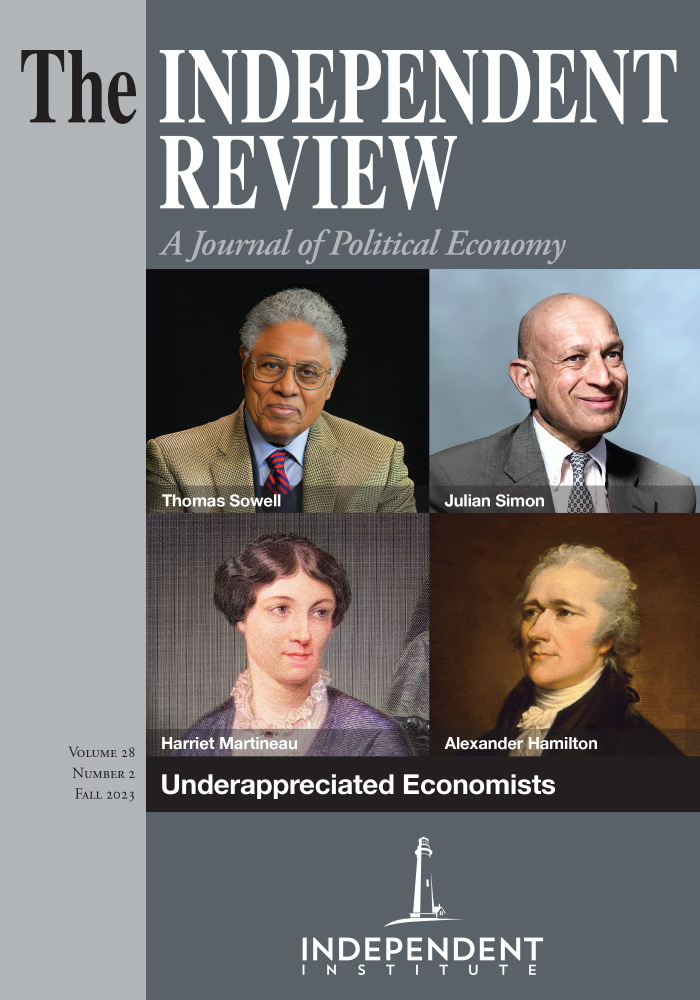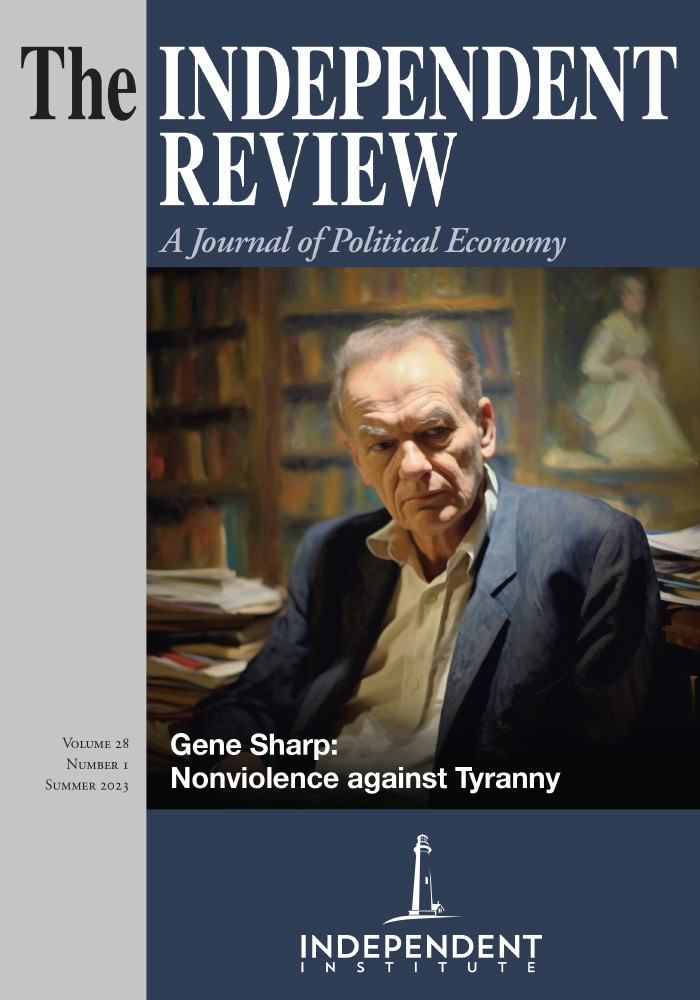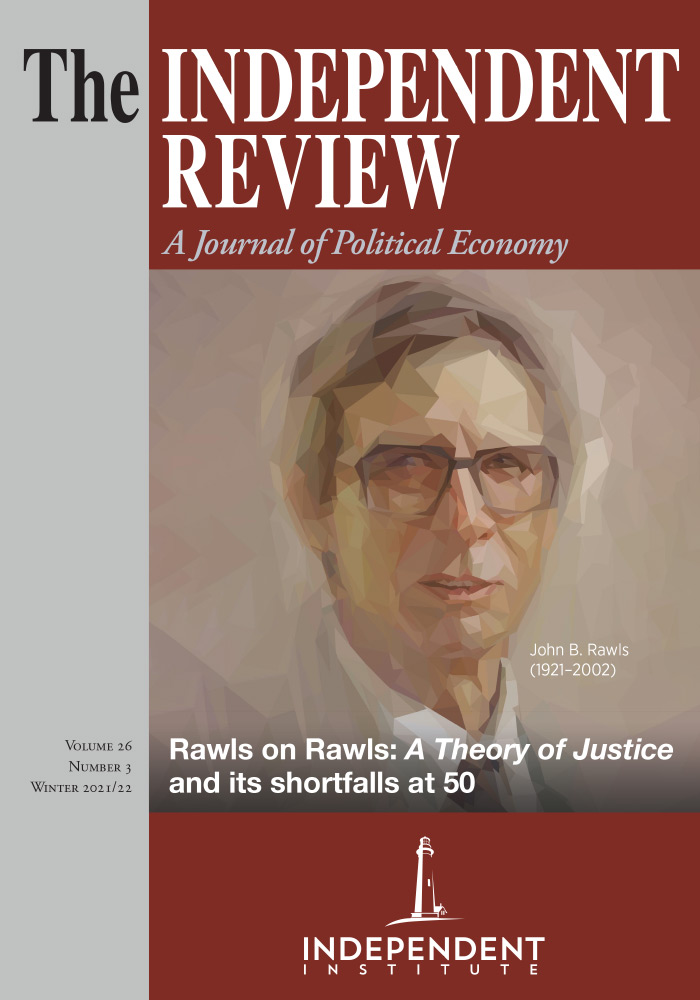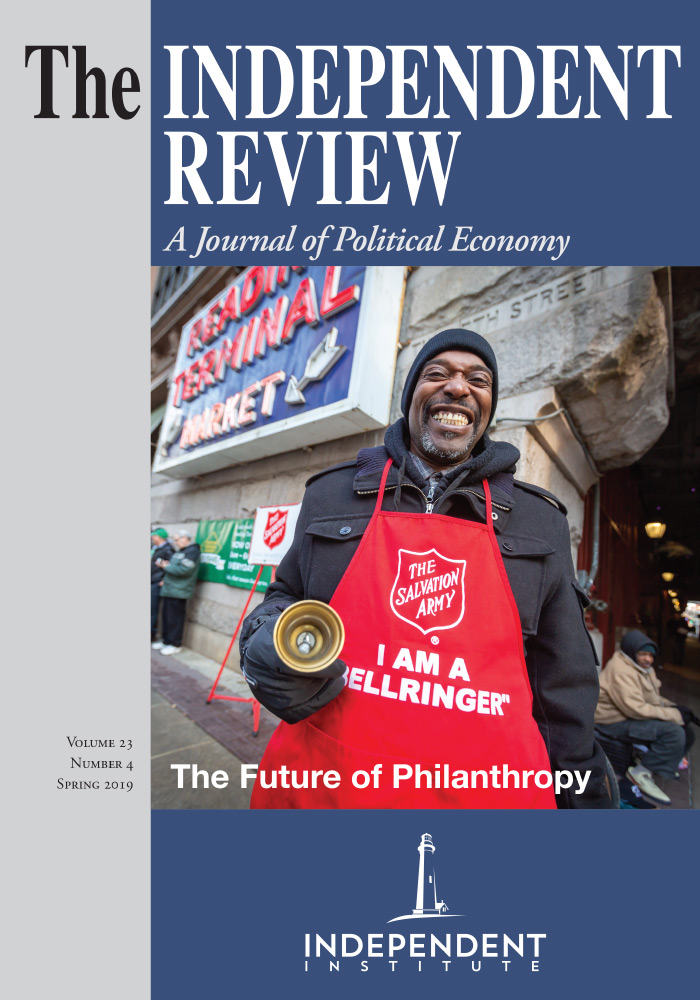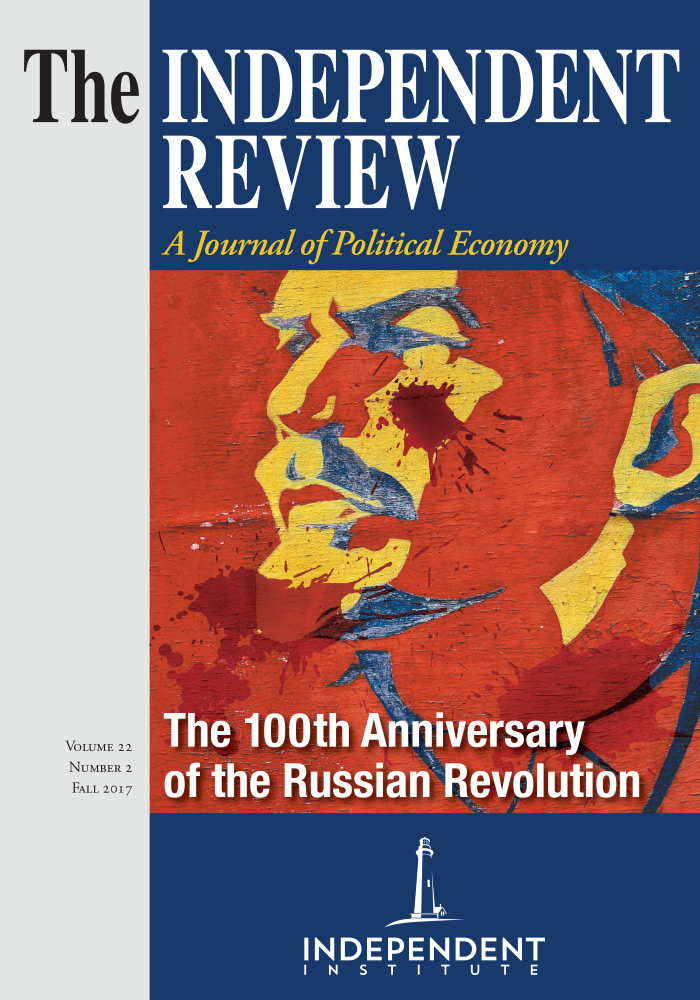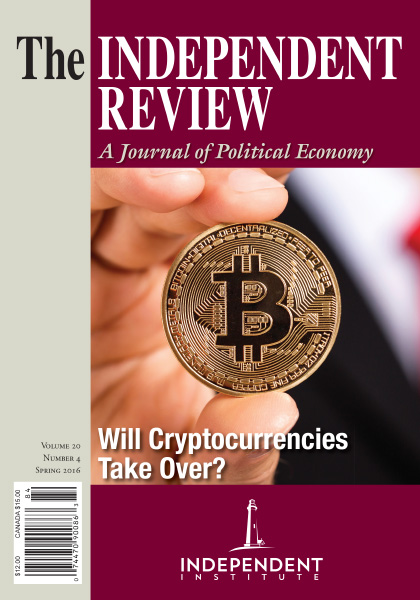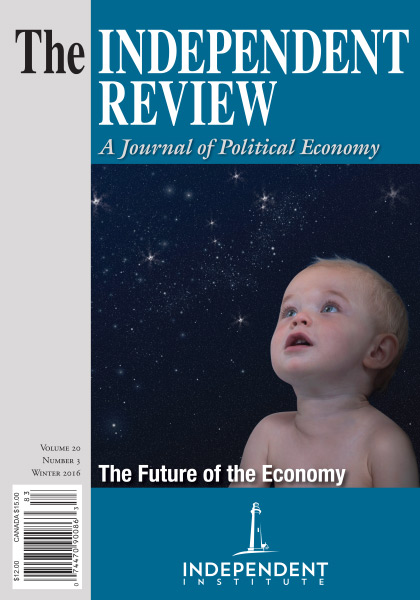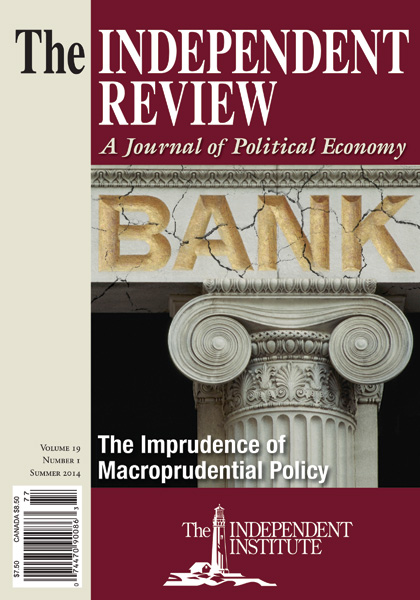Economists often defend public schooling on the grounds that education indirectly helps people who wouldn’t pay voluntarily for the benefits they receive from it and thus would be undersupplied if left exclusively to private funding. Yet by the same reasoning, quality assurance in the government provision of services also creates uncompensated spillover benefits and thereby leads to a deficiency of quality in public schooling.
Article
Education is, to a considerable extent, a private good. Purchasers of education benefit directly from what they pay for. Education is often viewed, however, also as a public good, primarily because of its positive spillover effects. In this article, I question that description and go even further, suggesting that given the way education is provided in the United States, it is at least in part a “bad” public good.
For economists, a public good is not simply something that is “good for the public”; it is something that benefits many people, including those who do not pay for it. Learning to read and write helps the individual and in that sense is a private good, but it also provides a public good because it makes people better citizens, acquaintances, and colleagues—contributing to the lives of others, even though they do not pay for those benefits. Advanced education similarly fosters greater productivity and innovation, improving the lives of everyone, not just those who bought the education.
In other words, education has positive externalities whose value is not captured by the person who pays for the education. Because these externalities exist, the argument goes, people tend to act as “free riders,” receiving the benefit provided by others without paying for it. Thus, fewer people are willing to provide education than would be willing without such spillovers because they are not rewarded for some of the output they produce. Therefore, according to most economists, education will be undersupplied (Cowen 2007).
A related argument states that if we were to rely on private education only, poor people would never obtain it. Although they would have an incentive to obtain education (for themselves or their children), that private incentive would not ensure that they would get “enough” education to satisfy society’s needs.
These arguments lead inevitably to the claim that the government must help to provide education, and, indeed, governments are heavily engaged in supplying this “public good.” As David Haddock writes in the introduction to a conference volume on “bad public goods,” “When ideal amounts of a good cannot adequately be provided privately, many people, economists and non-economists alike, argue that tax-financed provision should be forthcoming from government. Call that the government-provision rationale” (2007, italics in original). Aided by this government-provision rationale, governments spend hundreds of billions of dollars each year on education in the United States.
The problem with public provision is that the task of ensuring that the government supplies the proper quantity and quality of “public goods” is itself a public good. Haddock cites Gordon Tullock (1971) and Richard Stroup (2000) in making this point. When the government supplies a product, paid for indirectly by taxpayers rather than by the direct recipients of the product, few have an incentive to spend the time and resources to make sure that the government supplies the right quantity and quality. If the theory of public goods is correct, relatively few people are likely to spend time and resources making sure that someone else’s education (or health care or justice) is adequate.
In other words, monitoring and controlling a publicly provided good suffer from the same incentive problems that caused the supposed undersupply in the first place. Because very few people will benefit noticeably from, say, saving millions of dollars spread across the nation’s millions of taxpayers, only a few people will have a direct interest in monitoring and ensuring good management of public agencies. Their inability to capture major benefits from their efforts is likely to cause their efforts to be undersupplied. As a result, the public good may be provided badly—oversupplied, undersupplied, or poorly supplied. Stroup summarizes this argument by saying that “the root of those problems is precisely the same as that of the freerider problem associated with private production of public goods” (2000, 485). No one has a strong incentive to make sure that the public good is well provided.
If so, we should expect the provision of poor-quality education, which indeed is what we often see. The theory underlying this article is that incentives to monitor the provision of public goods are lacking, especially when the good is provided through a government agency. Funded through taxation, rather than through voluntary purchases, public entities have monopolistic power—without even the restraint of traditional monopolies, which must obtain their revenues from voluntary purchases. Moreover, the government schools operate largely without competition.
To the extent that competition can be introduced into public provision of a public good, the outcomes should be better. A study by Andrew Coulson of the Cato Institute compares government-run schools and free-market schools in terms of academic achievement, parental satisfaction, and other measures. Coulson finds that when market-based school systems are compared to monopoly-run school systems, “there are 35 statistically significant findings of market-like education systems outperforming government monopoly schooling, and only two findings of the reverse, for a ratio of more than 17 to 1 in favor of free education markets” (2008, 10).
Even with government-supplied products, competition can be critical; Gordon Tullock and his colleagues recommend federalism because it allows competition (Tullock, Seldon, and Brady 2002, 76). In a federal system composed of numerous states, different governments compete with one another to provide services to the consuming public. Although movement is costly, consumers do move from one jurisdiction to another, providing a check on bad government (Tiebout 1956).
Not all education is provided by governments, of course. In particular, higher education (postsecondary education) has many private providers (although most students now attend public universities). Because the market is national and even international, even government universities face competition (the University of Michigan competes with the University of Virginia, for example). But most postsecondary schools are nonprofit and have tax-exempt status.
The nonprofit status of most colleges and universities reflects the assumption that education is a public good, an assumption that goes back at least to the charter of Harvard College, which in 1650 exempted its property from “all civil impositions, taxes, and rates” (Harvard Charter 1650). As Robert E. Martin (2009) has explained comprehensively in The Revenue-to-Cost Spiral in Higher Education, this nonprofit status distorts the schools’ incentives. These distortions, however, do not typically come close to the effects of direct public provision.
K–12 Education
In the United States, K–12 public education (increasingly called “P–12” because it now often starts with preschool) takes place primarily within a government system. Its ills have been widely known and discussed for years, especially since 1983, when a federal panel issued a sweeping condemnation of public elementary and high school education called A Nation at Risk (National Commission on Excellence in Education 1983). Nevertheless, the problems persist. U.S. students do not score well on tests in comparison to similar-age youth of other industrialized nations; dropout rates are high; and anecdotes abound of the low skills of many high school graduates (see, for example, National Center for Education Statistics 2007a and n.d.).
K–12 education historically was financed primarily through property taxes and state funding. Since 1965, however, the federal government has gradually become an important source of funding and rule making. In 2007, the federal government spent $147.5 billion on education, according to the U.S. Department of Education (National Center for Education Statistics 2008).
The taxpayer’s money is spent through an education bureaucracy involving local, state, and federal levels. Attendance is compulsory, usually until age sixteen or eighteen, and parents have little choice about the school their children attend. They may attempt to exercise choice by moving into one school district rather than another (often paying a high price to do so), but even then they cannot always be assured that their children will attend the neighborhood school. In some school districts, the management can require students to be bused to other schools for a variety of reasons, including overcrowding. In Wake County, North Carolina, for example, it has been the policy for many years to increase the socioeconomic diversity of students in all of the government schools by dispersing students around the county.
Voluntarily chosen “magnet” schools—schools that offer special attractions and accept out-of-district students, usually to encourage racial and ethnic integration—offer some choice, but even these opportunities are limited. An article in the Raleigh News and Observer points out that it is difficult for parents to get their child into the magnet school they want. “It’s a lottery, more or less,” says Bonnie Rochman (2007).
Given this public monopoly, it is difficult to monitor and improve quality. Although parents can complain, protest, and intervene in specific situations, they have a difficult time “taking their business elsewhere,” although some do so. They must pay for the public schools through taxes whether their children attend those schools or not.
Private schools provide an alternative, but parents who patronize these schools essentially pay for education twice. As a result, only about 11 percent of all children attend a private school. Even so, some parents, even poor ones, do send their children to nonpublic schools, including Catholic schools. Although home schooling poses logistical and educational challenges for parents, it has grown enormously in recent decades. The U.S. Department of Education estimates that 1.1 million students are being schooled at home, but these figures seem small in light of anecdotal information (Lips and Feinberg 2008).
It has taken decades to bring some choice to public education in the form of vouchers and charter schools, and those choices remain extremely limited. Vouchers allow children to transfer to private schools, with some public funds being transferred along with the student, but obtaining a voucher system has been an uphill battle. Many states have no programs authorizing vouchers. In a discouraging move (both in its actual force and its symbolic impact), the U.S. Congress ended the D.C. Opportunity Scholarships programs in 2009. These scholarships allowed students who attended poor schools in the district to attend better ones, including private schools, such as the famed Sidwell Friends. Teacher unions and public-school administrators oppose such vouchers because they lose the allocated per child funds (or a large portion of them) when students transfer out.
Charter schools, which also offer some choice, are more widespread. They are public schools that are allowed to operate with fewer restrictions than typical public schools. Some states, however, do not authorize charters at all, and others hem them in with restrictions and bureaucratic red tape (Allen, Consoletti, and Hornung 2009). For example, the North Carolina legislature has limited the number of charter schools in the state to one hundred, even thought the state has 1.5 million public K–12 students. As a result, these charter schools have long waiting lists, and admission is determined by lottery. A positive sign for charters is that the Obama administration has spoken favorably of them and criticized states’ limits on their number.
All these movements—private schools, home schooling, and charters—are attempts to bring competition into a system where it is lacking. They face significant opposition from teachers’ unions and school administrators, who can muster considerable political power at the ballot box. The opposition appears to be grounded primarily in self-interest, not in the theory of public goods, because even if education is entirely a public good and subject to government support, nothing in public-good theory suggests that the state must operate the schools.
The condition of our public schools is so poor that the government itself has tried reforms through federal legislation. In 2001, Congress passed the No Child Left Behind Act, which requires schools to test students annually, and if significant numbers of students fail to meet the specified standards for a period of years, the children in that school are allowed to attend other schools in the system. The law has come under severe criticism. One criticism is that poorly performing school districts can get away without actually making serious improvements (Hess and Kendrick 2007).
Federal, state, and local governments have poured money into such school districts (as well as into well-performing ones), thus putting per pupil expenditures among the highest in the world. In 2005–2006, the average expenditure per pupil for elementary and secondary public schools was $9,154 (National Center for Education Statistics 2009).
Some private foundations are working with the public-school system to improve it. For example, the Bill and Melinda Gates Foundation has supported the creation of smaller schools in the public system. Yet it is impossible to make a case that students are doing any better than they were when the alarm was sounded in 1983. Both the private-good and public-good aspects of K–12 are being inadequately provided by the government system.
Higher Education
The reputation of American higher education is far better than the reputation of the K–12 system—or at least it has been until recently. The nation’s higher education is often called the “envy of the world” and the “crown jewel” of the nation’s education system.
This description is bestowed for a number of reasons. One is the existence of many admired research institutions. Graduate students from all over the world are attracted to these universities, and Nobel prizes are frequently awarded to their faculty members. Another reason for its being the “envy of the world” is the widespread availability of higher education; more students until recently went to a college or university in the United States than in other industrialized nations. Now, however, a number of countries are increasing the proportion of students in college, which has caused federal policymakers, including President Barack Obama, some concern. (Figures suggesting that some countries have higher participation rates than the United States are rife with uncertainty, however.) In any case, the sheer number of institutions in the United States—more than 2,500 four-year colleges and universities—has no equal in any other country.
Even though higher education may, at least arguably, be producing a public good, it is doing so through a complex and diverse market that differs dramatically from the world of K–12 education. American higher education is unlike the K–12 universe in numerous ways:
- It is less “public.” According to the U.S. Department of Education (National Center for Education Statistics 2007b), approximately 24 percent of college students attend private schools. (The figures are based on attendance at most degree-granting schools, including two-year schools.) At the K–12 level, 11.1 percent of students go to private schools. (This figure does not include home schoolers, whom the Department of Education estimated to number 1.1 million in 2003; as noted, though, anecdotal information suggests that the number may be much larger [Lips and Feinberg 2008]).
- Postsecondary students pay a substantial portion of the cost of their education even at public universities and colleges. Tuition, living costs, and the availability of scholarships affect decisions by students and their parents about where to attend school. Although tuition at public universities is subsidized and federal student aid is significant, students still pay a portion of the total cost. Students at K–12 do not pay for public schools, at least not in a direct, financial way.
- Potential college students engage in search. Unlike most K–12 students (or their parents), college students are often willing to move across a state or the country or even abroad to attend the college of their choice. They are willing to look carefully or listen to friends and experts about where to attend college. (As noted previously, in the K–12 arena, parents often search for appropriate school districts, but that choice must be weighed against other factors in deciding where to live. Such a search may not be effective, anyway, because school districts can prohibit students from attending neighborhood schools.)
- The market is diverse. Higher-education institutions include nonprofits, government-owned schools, and profit-making schools. Schools have different niches, with different goals, such as engineering, liberal arts, research, business, religious education, and so forth. They offer different levels and varieties of sports and extracurricular activities and have different religious heritages, traditions, and reputations. Their demands on students vary significantly from school to school (and within schools).
- Prices vary, especially because of price discrimination by universities that offer merit scholarships to attract desirable students.
- Education entrepreneurs supply information to potential students and their parents. The schools themselves have become highly skilled marketers. U.S. News & World Report and Forbes provide rankings and information about many schools, as do many other publications. The Princeton Review issues reports on the quality of life at schools; Washington Monthly ranks schools on public service, Mother Jones on activism, and Kiplinger’s Finance on best value.
- Although the federal government provides substantial financial support to students, the students essentially can carry student aid with them. Even the subsidies implicit in funding of state universities are portable to the extent that the state has a variety of public schools. Thus, some government funds are used like vouchers, thus increasing competition.
- Attendance at a college or university is not compulsory.
This varied marketplace should lead to more effective provision of education at the higher levels, which seems to be the case.
The Private Good of Education
The foregoing discussion rests on the assumption that education is a public good. But is it? Education may be so valuable as a private good that virtually everyone wants it, and thus the externalities, though they may exist, might be irrelevant. Such may well be the case with K–12 education; the demand for some amount of education (reading, writing, and arithmetic) may be so great that it would be sufficiently provided even if there were no government schools. Thus, for K–12, the only legitimate “public-good” argument may be that some parents are too poor or too inadequate as parents to provide this good for their children.
As for higher education, the private benefit of college is also large; statistics indicate that a college degree raises earnings significantly above those of a high school graduate. One estimate is that the increase in income due to a college degree is about 75 percent (Vedder 2004, 34). Others emphasize that figure’s uncertainty (Schneider 2009), but they still recognize a difference.
However, the benefit for the marginal student (who is likely to attend in increasing numbers as more pressure is applied to go to college) may be far less (Leef 2006;Murray 2008). One reason is that the student may not be able to finish school. If the student has incurred significant debt, college may be a losing proposition.
Nevertheless, it can be argued that the rewards for the able student are large enough that the private-good aspect of higher education swamps the public-good aspect. The financial rewards—whether presumed or actual—help to explain why many students and their families are willing to pay high tuition, travel long distances, and forgo other income-generating opportunities while the students attend college. Indeed, viewed from the perspective of the university official, the vocational benefit of a college degree is so important that schools are providing college degrees in areas such as interior design and hotel, motorsports, and golf course management to make sure that students keep coming.
Community colleges, although somewhat neglected in public discourse until recently, are part of the higher-education system, especially of its vocational component. They provide both short-term (typically two-year) vocational degrees and associates’ degrees, which allow transfers to four-year colleges. Usually supported by both county and state taxes, they also receive tuition, including tuition from members of the local community who are seeking education without degrees (for example, pottery classes, foreign-language instruction, driver’s education). Although most students come from the local county, the absence of compulsory attendance maintains an element of competition.
Even more neglected are for-profit schools, which now represent at least 9 percent of postsecondary enrollment. These schools are vocationally oriented and tend to be directed toward working adults, often those with low incomes. Their students rely heavily on federal funds.
To some extent, vocational education has always been an element of higher education. Most U.S. universities were initially devoted to educating clergymen, and for many decades they have produced teachers, business executives, lawyers, engineers, and other professionals. The vocational or private-good aspect of education should give rise naturally and inevitably to some of the public-good benefits indicated at the beginning of this article, such as the ability to communicate and work with others and even some elements of citizenship. Thus, the private pursuit of education should have beneficial spillover effects. Whether these benefits suffice to compensate for the supposed insufficiency of education (the justification for government intervention) is considered later in this article.
So What’s Wrong with Higher Education?
Higher education has some serious problems. For some students, universities are not even fulfilling the vocational (private) goals—a fact that is beginning to arouse attention, as one test after another suggests. And there is growing evidence that the public good—such as producing an informed populace capable of self-support and intelligent selection of public officials—is getting short shrift.
The crown jewel is “tarnished” (to quote Richard H. Hersh and John Merrow [2005b, 1]). The complaints about higher education in the country (too numerous to list here, but available on the Pope Center Web site at popecenter.org) include the following. Business employers complain about college graduates’ poor performance in such basics as writing and math; the National Assessment of Adult Literacy (National Center for Education Statistics 2007c) reports that proficiency in reading documents and literature has diminished among college-educated adults. Surveys of college students by the Intercollegiate Studies Institute (2008) indicate that knowledge of American history, economics, and civics is poor among college graduates. Costs continue to rise faster than inflation. Overemphasis on athletics has led to acceptance of students who are poorly prepared for college and then are forced to spend most of their time developing athletic skills, not academic ones.
The advent of the “research university,” especially its growth since World War II, has redirected talent to federally funded research and away from teaching. Richard Vedder finds that the percentage of a university’s resources that goes to instruction fell from nearly 40 percent of the total in 1976–77 to just less than 34 percent in 1999–2000. Research time over that period has gone from 18.4 percent to 22.4 percent (Vedder 2004, 45). In the name of providing one public good (research), the federal government has reduced the time devoted to another public good (education).
Faculty are increasingly isolated in their ivory towers and thus less able and willing to provide the education characteristically considered a public good. The so-called culture wars (disputes between the political Left and Right and between novelty and tradition in the curriculum) are fought mostly in academia, especially in the humanities, the departments where liberal learning used to be taught. Some of the battles have pertained to the devaluation of literary and philosophical works considered “the canon.”
The Public Good of Higher Education
Although the element of competition is strong in higher education, this industry differs from a typical private marketplace. Indeed, the “public-good” justification means that the vast majority of today’s colleges and universities are either public universities or nonprofit private ones. Can this simple fact—that the institutions are nonprofit organizations—explain the tarnishing of higher education?
The answer is probably yes. Robert E. Martin (2009) has described higher education as an “industry,” but one composed mostly of organizations that do not make profits and therefore have no residual claimants (i.e., owners who reap the rewards of good decisions and pay the cost of bad ones). Because these organizations do not have a profit goal, they forgo the traditional ways of measuring success and achieving efficiency found in corporations and other profit-seeking entities. They do have financial goals, of course, but without a profit motive, surplus funds seep throughout the system, and there is no measurement of efficiency. Furthermore, it is difficult to know which expenditures are worth making and which are not.
In this environment, shared governance has evolved among administrators, trustees, faculty, students, and alumni—in order to ensure that one group monitors another, according to Martin. This mutual monitoring has broken down over time, however, as each group focuses on narrow objectives.
Ronald G. Ehrenberg’s (2000) wryly amusing account of his years as a vice president at Cornell reveals an institutional framework that actively defeats efficiency in the production of education. (Cornell is something of a public-private hybrid; most of its schools are supported by the state, but some are supported by the university’s endowment.) Some of the reasons for higher costs at this large, highly ranked school are: faculty have the power to resist efficiency-enhancing moves; deans decline to recognize the relative costs of space; and separate colleges within a university offer duplicate courses so they can avoid paying internal transfer funds. Although Ehrenberg is writing about a specific school, his experiences are widely applicable.
Of course, one might argue that because an organization provides a “public good,” it should be exempt from an efficiency test. And, indeed, a university’s mission is education, not profit. Yet the inefficiencies that Ehrenberg points out deter the effective use of resources for education. Without profit, there is no clear way to determine how those resources are being misused. As Haddock, Stroup, and Tullock have pointed out, preventing a public entity from wasting its resources depends on enlisting the interest of third parties, most of whom have little incentive to monitor that entity.
Ehrenberg’s experience recalls Adam Smith’s comments on education. Smith noted that a teacher is more likely to teach well when fees from students support him. When the teacher is supported by the state or the university, not by student fees, the teacher’s personal interest is “set as directly in opposition to his duty as it is possible to set it,” Smith wrote, pointing out that at Oxford “the greater part of the public professors have, for these many years, given up altogether even the pretence of teaching” ([1776] 1998, 871.) As a contrast, Smith noted that in fencing and dancing, which lacked publicly supported institutions, a young man “seldom fails of learning to fence or to dance” (875). This success is not likely to occur in a public institution. Smith also commented that because in his time the education of women was entirely private, “there is accordingly nothing useless, absurd, or fantastical in the common course of their education” (891).
No More General Education
The greatest loss in higher education ironically may be the loss of its nonvocational aspect, known as “general education” or “liberal arts education.” This is the part of the curriculum that, to use University of North Carolina phrasing, “focuses on the development of the whole person.”
This depletion is ironic because historically one justification for the public-good nature of colleges and universities was that they taught young men to be gentlemen—for the sake of the country. Harvard’s charter of 1650 exempted the school from taxes because the school’s activities would “conduce to the education of the English and Indian youth of this country, in knowledge and godliness.” Development of the whole person may be the essential justification for supporting education through public funds: students become better people as a result of their education, and therefore society becomes better, too. Teaching about individual freedom, democracy in the context of limited government, and responsibility for one’s actions is typically (or at least once was) part of general education, which has also been called “liberal learning.”
Yet modern education has stunted the “development of the whole person.” Harry Lewis, former dean of Harvard College, has argued that the undergraduate programs in top research universities such as Harvard are failing in their “larger mission.” “Universities have lost the sense that their educational mission is to transform teenagers, whose lives have been structured by their families and their high schools, into adults with the learning and wisdom to take responsibility for their own lives and for civil society” (2006, xiv).
Dealing with the Bad Public-Good Problem
It appears that the “bad public-good problem” with respect to education arises because its provision tends to be monopolistic in the case of K–12 education and riddled with perverse incentives in higher education, even when the providers are private nonprofits.
In elementary, secondary, and postsecondary school, private demand should be recognized as the most powerful force in encouraging good education. If K–12 children were not locked into a single monopolistic system, schools probably would emerge, as they did in the past, to provide the first level of education with complete sufficiency. Indeed, many parents who lack teacher certification and education courses clearly can prepare their children with a basic education. Home-schooled children are said to be among the most successful in traditional education, as attested by spelling bees, among other things. Overall, the biggest challenges are to bring in alternatives such as vouchers and charters and to give greater freedom to home-schooling parents.
As for higher education, a bachelor’s degree has been so valuable as a credential that actual education has not been an issue. The novelist Tom Wolfe has called the bachelor’s degree an “essential punch on the ticket for starting off in any upscale career” (2005, xi). (Parents also want their offspring to come into contact with appropriate marriage prospects.) The reputation of schools, which has been intensified by the U.S. News & World Report ratings, has been a major factor leading parents to choose one school over another.
If the private value of the credential goes down, however, we would expect to see a reaction by parents, and that may be happening already. George Leef, in The Overselling of Higher Education (2005), cites Anne Matthews’s claim that one in five college graduates is working at a job that does not require a college degree (she claims that one-third of Domino’s pizza delivery people have a bachelor’s degree). Just having a degree these days may not justify the expense of getting it. Time magazine recently published an article titled “The Job Market: Is a College Degree Worth Less?” (Oloffson 2009), suggesting that, indeed, it is.
If this situation persists, we can expect some changes in the choices made by students and their parents. Indeed, recent public attention to “student learning outcomes” and school accountability (furthered by the 2006 report of the Commission on the Future of Higher Education) may reflect the disenchantment of parents who find college to be overly expensive and not necessarily of much benefit to their children.
One force slowing down this careful scrutiny of college is that many students and their families do not pay the full cost of their education. Statistics provided by the U.S. Department of Education (National Center for Education Statistics 2007b) indicate that at public universities, tuition covers only 35.4 percent of educational and general expenses; taxpayers, alumni, and other donors provide most of the rest. If students and their parents were carrying the full load, they might insist more strenuously on high quality. As many states back away from providing funds for universities and as tuition rises, students and their parents may become more careful shoppers.
More careful shopping by students and parents may be all that is required to spur an educated populace, the public good that is sought through education. David Haddock (2008), building on work by James Buchanan and Craig Stubblebine, has argued that a minority of people seeking a private good may eliminate the need for public provision—especially when one takes into account that public provision brings with it the deficiencies and problems described in this article.
In his 2008 paper “Irrelevant Externality Angst,” Haddock introduces the concept of “avid demanders.” He argues that “an individual who acts self-interestedly and unilaterally may provide an efficient amount of a public good” (4). Some users are so eager for the good that their desires can lead to significant provision without government intervention. “A public good, even one enjoyed by a very large public, creates no policy issue if other people are satiated by the most avid demander’s voluntary decisions,” writes Haddock (16). (Furthermore, he notes, if others want more, in many cases the avid demanders can negotiate among themselves to obtain provision.) According to Haddock, anyone who really wants a good is an avid demander, and the strong demand may provide all but a trivial amount of the public good.
So are there “avid demanders” for education? We have certainly seen such demanders in K–12 education, both parents and third parties. Many organizations, from the national Friedman Foundation for Educational Choice to the local Parents for Educational Freedom in North Carolina, have tried to bring reform to K–12 education. In spite of enormous opposition, they have made some headway. The difficulties they face stem from the self-interest of providers in the public sector, who have the power of a virtual monopoly backed by government coercion. The avid demanders have a hard slog ahead of them in K–12 education. In higher education, in contrast, the prospect for avid demanders is brighter. But we should not look to students to play this role. Few nonadults yearn for moral upbringing or the inculcation of virtue or even the basics of a challenging education.
“Helicopter parents”—the somewhat caricatured parents who become intensely involved in their students’ college experience (to administrators’ annoyance)—are more promising interventionists. They illustrate one extreme of the “avid demander.” If they insist on high educational quality, the benefits may spill over to many others. If these parents’ goals (which typically, it appears, are vocational and marital success for their children) foster better education for many students—by operating like class-action suits—the public good of higher education may be provided privately. Parents who are simply well informed and outspoken may alternatively play this role without the extreme involvement of “hovering.”
Other avid demanders—third parties—also exist. Their potential impact on higher education is greater because there is more competition in higher education than in K–12 and thus more pressure points. The groups that got their start in the “politically correct” era of the 1980s and 1990s, such as the American Council of Trustees and Alumni and the National Association of Scholars, are being supplemented and the movement invigorated by newer entrants, including the John William Pope Center for Higher Education Policy, the Manhattan Institute’s Center for the American University, the Cato Institute, and Richard Vedder’s Center for College Affordability and Productivity.
Encouraged by the Philanthropy Roundtable and the National Association of Scholars, alumni and other donors have created centers on (or near) campus that aim to restore more traditional attitudes about what is important in learning and to serve as counterweights to antimarket and postmodern tendencies on campuses. These centers include the James Madison Center at Princeton, the Gerst Program at Duke, and the Alexander Hamilton Institute near Hamilton College. These centers deal with the failures of the “public-good” side of the higher education ledger because they deal with citizenship and restore some of the educational heritage developed over centuries.
Although people of many ideologies have detected the tarnishing of the modern university (Derek Bok [2006], Harry Lewis [2006], and the authors of the essays in the volume Declining by Degrees, which appeared in tandem with a PBS documentary [Hersh and Merrow 2005a]), the “avid demanders” tend to be more aggressive and generally conservative in ideology. They oppose the university’s dominance by faculty they view as opposed to tradition, individualism, limited government, capitalism, and perhaps even open inquiry. They are trying in a variety of ways to correct what they see as the most serious “public-good” problems. And they may succeed. (See, for example, my online article “How to Reform from the Ground Up” [Shaw 2009]).
Conclusion
I began this article with the assumption that education is at least in part a public good—that is, it has spillover benefits that people do not normally pay for; thus, people are likely to be “free riders” on the education that is provided. Under current (or at least recent) economic theory, the assumption is that education will be suboptimally provided. This probable underprovision has led to the claim that the government must intervene to provide education. And, indeed, at all educational levels (except for the first few years after birth), there is substantial government provision of education in the United States and elsewhere.
The problem that arises is that the quality of government-provided services, including education, is often poor. Citing work by Stroup and Tullock, Haddock points out the reason: government provision of services is also a public good. It provides many services for which the recipient does not pay. Those recipients tend to become free riders. They thus do not provide the quality of monitoring that they would provide if they were direct payers for the service.
However, private activity may yet compensate for the free-rider problem in the public provision of education. Education is also a private good, and its avid demanders may stimulate adequate provision of that good. In K–12 education, some avid demanders (such as home-schooling parents, other parents, and organizations such as the Friedman Foundation) have brought about some elements of competition. In the higher-education field, substantial market competition already occurs for the private good, and avid demanders are active there.
References
Allen, Jeanne, Alison Consoletti, and Kara Hornung. 2009. Charter School Laws across the States: Rankings and Scorecard. 11th ed. Washington, D.C.: Center for Education Reform.
Bok, Derek. 2006. Our Underachieving Colleges. Princeton, N.J.: Princeton University Press.
Commission on the Future of Higher Education. 2006. A Test of Leadership: Charting the Future of U.S. Higher Education. Washington, D.C.: U.S. Department of Education.
Coulson, Andrew J. 2008. Markets vs. Monopolies in Education: A Global Review of the Evidence. Cato Policy Analysis no. 620. Washington, D.C.: Cato Institute.
Cowen, Tyler. 2007. Public Goods. In Concise Encyclopedia of Economics. Available at: http://econlib.org/library/Enc/PublicGoodsandExternalities.html.
Ehrenberg, Ronald G. 2000. Tuition Rising: Why College Costs So Much. Cambridge, Mass.: Harvard University Press.
Haddock, David D. 2007. Bad Public Goods: The Public Goods Paradox: Quis custodiet ipsos custodies? Preconference paper. Typescript in author’s possession. February 22.
———. 2008. Irrelevant Externality Angst. Journal of Interdisciplinary Economics 19: 3–18. Harvard Charter. 1650. Harvard University Archives, Cambridge, Mass. Available at: http://hul.harvard.edu/huarc/charter.html.
Hersh, Richard H., and John Merrow, eds. 2005a. Declining by Degrees: Higher Education at Risk. New York: Palgrave.
———. 2005b. “Introduction.” In Declining by Degrees: Higher Education at Risk, edited by Richard H. Hersh and John Merrow, 1–9. New York: Palgrave.
Hess, Frederick, and Rosemary Kendrick. 2007. Too Many Remedies? Education Week, September 25. Available at: http://www.aei.org/publications/filter.all,pubID.26869/pub_detail.asp.2007.
Intercollegiate Studies Institute. 2008. Our Fading Heritage. Summary. Wilmington, Del.: Intercollegiate Studies Institute. Available at: http://www.americancivicliteracy.org/2008/summary_summary.html.
Leef, George. 2006. The Overselling of Higher Education. Inquiry Paper no. 25. Raleigh, N.C.: John William Pope Center for Higher Education Policy, September 5. Available at: http://popecenter.org/inquiry_papers/article.html?id=1725.
Lewis, Harry R. 2006. Excellence Without a Soul: How a Great University Forgot Education. New York: Perseus Books Group.
Lips, Dan, and Evan Feinberg. 2008. Homeschooling: A Growing Option in American Education. Washington, D.C. . Heritage Foundation, April 3. Available at: http://www.friedmanfoundation.org/newsroom/ShowNewsItem.do?id=80224.
Martin, Robert E. 2009. The Revenue-to-Cost Spiral in Higher Education. Raleigh, N.C.: John W. Pope Center for Higher Education Policy. Available at: http://popecenter.org/inquiry_papers/article.html?id=2196.
Murray, Charles. 2008. Real Education. New York: Crown Forum.
National Center for Education Statistics. 2007a. Dropout Rates in the United States: 2005 June. Table 12: Averaged Freshman Graduation Rates of Public High School Students, by State. Available at: http://nces.ed.gov/pubs2007/dropout05/tables/table_12.asp.
———. 2007b. Enrollment in Educational Institutions, by Level and Control of Institution: Selected Years, Fall 1980 Through Fall 2006. In Digest of Education Statistics, table 2. Available at: http://nces.ed.gov/programs/digest/d06/tables/dt06_002.asp?referrer=report.
———. 2007c. National Assessment of Adult Literacy: Key Findings. Available at: http://nces.ed.gov/naal/kf_dem_edu.asp.
———. 2008. Federal On-Budget Funds for Education, by Level/Educational Purpose, Agency, and Program: Selected Fiscal Years, 1970 Through 2008. Digest of Education Statistics, table 375. Available at: http://nces.ed.gov/programs/digest/d08/tables/dt08_375.asp.
———. 2009. Fast Facts. Available at: http://nces.ed.gov/fastfacts/display.asp?id=66.
———. n.d. Trends in International Mathematics and Science Study 2003. Available at: http://nces.ed.gov/timss/results03.asp.
National Commission on Excellence in Education. 1983. A Nation at Risk. Washington, D.C.: National Commission on Excellence in Education. Available at: http://www.ed.gov/pubs/NatAtRisk/index.html.
Oloffson, Kristi. 2009. The Job Market: Is a College Degree Worth Less? Time, December 8. Available at: http://www.time.com/time/business/article/0,8599,1946088,00.html.
Rochman, Bonnie. 2007. The Magnet Muddle. (Raleigh, N.C.) News and Observer, October 30.
Schneider, Mark. 2009. How Much Is That Bachelor’s Degree Really Worth? Washington, D.C.: American Enterprise Institute, May. Available at: http://www.aei.org/outlook/100034.
Shaw, Jane S. 2009. How to Reform from the Ground Up. Raleigh, N.C.: John W. Pope Center for Higher Education Policy, November 10. Available at: http://www.popecenter.org/clarion_call/article.html?id=2257.
Smith, Adam. [1776] 1998. An Inquiry into the Nature and Causes of the Wealth of Nations. Washington, D.C.: Regnery.
Stroup, Richard L. 2000. Free Riders and Collective Action Revisited. The Independent Review 4, no. 4 (Spring): 485–500.
Tiebout, C. M. 1956. A Pure Theory of Local Expenditures. Journal of Political Economy 65 (October): 416–24.
Tullock, Gordon. 1971. Public Decisions as Public Goods. Journal of Political Economy 79 (July–August): 913–18.
Tullock, Gordon, Arthur Seldon, and Gordon L. Brady. 2002. Government Failure: A Primer in Public Choice. Washington, D.C.: Cato Institute.
Vedder, Richard. 2004. Going Broke by Degree: Why College Costs Too Much. Washington, D.C.: AEI Press.
Wolfe, Tom. Foreword. In Declining by Decrees: Higher Education at Risk, edited by Richard H. Hersh and John Merrow, ix–xi. New York: Palgrave.
| Other Independent Review articles by Jane S. Shaw | ||
| Spring 2013 | The Locavore’s Dilemma: In Praise of the 10,000-Mile Diet | |
| Summer 2009 | Montessori, Dewey, and Capitalism: Educational Theory for a Free Market in Education | |
| Spring 2006 | Collapse: How Societies Choose to Fail or Succeed | |
| [View All (4)] | ||





